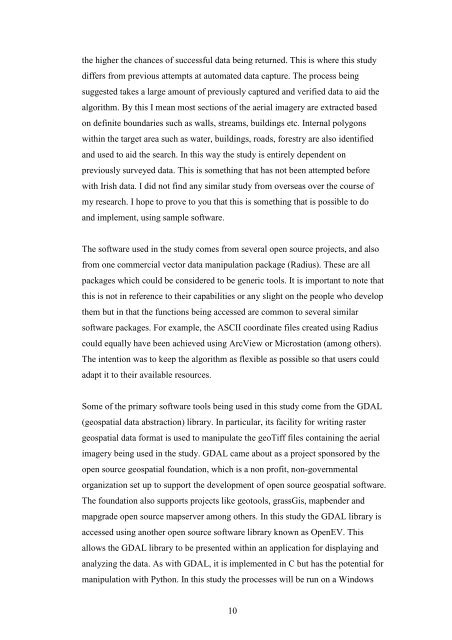You also want an ePaper? Increase the reach of your titles
YUMPU automatically turns print PDFs into web optimized ePapers that Google loves.
the higher the chances of successful data being returned. This is where this study<br />
differs from previous attempts at automated data capture. The process being<br />
suggested takes a large amount of previously captured and verified data to aid the<br />
algorithm. By this I mean most sections of the aerial imagery are extracted based<br />
on definite boundaries such as walls, streams, buildings etc. Internal polygons<br />
within the target area such as water, buildings, roads, forestry are also identified<br />
and used to aid the search. In this way the study is entirely dependent on<br />
previously surveyed data. This is something that has not been attempted before<br />
with Irish data. I did not find any similar study from overseas over the course of<br />
my research. I hope to prove to you that this is something that is possible to do<br />
and implement, using sample software.<br />
The software used in the study comes from several open source projects, and also<br />
from one commercial vector data manipulation package (Radius). These are all<br />
packages which could be considered to be generic tools. It is important to note that<br />
this is not in reference to their capabilities or any slight on the people who develop<br />
them but in that the functions being accessed are common to several similar<br />
software packages. For example, the ASCII coordinate files created using Radius<br />
could equally have been achieved using Arc<strong>View</strong> or Microstation (among others).<br />
The intention was to keep the algorithm as flexible as possible so that users could<br />
adapt it to their available resources.<br />
Some of the primary software tools being used in this study come from the GDAL<br />
(geospatial data abstraction) library. In particular, its facility for writing raster<br />
geospatial data format is used to manipulate the geoTiff files containing the aerial<br />
imagery being used in the study. GDAL came about as a project sponsored by the<br />
open source geospatial foundation, which is a non profit, non-governmental<br />
organization set up to support the development of open source geospatial software.<br />
The foundation also supports projects like geotools, grassGis, mapbender and<br />
mapgrade open source mapserver among others. In this study the GDAL library is<br />
accessed using another open source software library known as <strong>Open</strong>EV. This<br />
allows the GDAL library to be presented within an application for displaying and<br />
analyzing the data. As with GDAL, it is implemented in C but has the potential for<br />
manipulation with Python. In this study the processes will be run on a Windows<br />
10
















